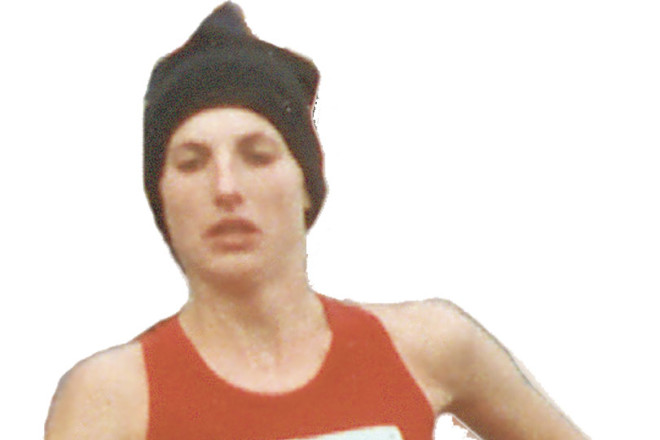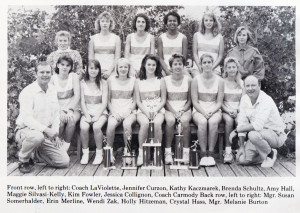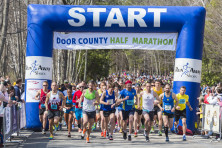Small Town Girl Runs with the Big Dogs
- Share
- Tweet
- Pin
- Share

Most elite runners arrive at events wearing high tech running gear in the company of their personal trainers and coaches. Wendi Ray travels with her parents and carries gloves that sometimes have holes in them. But unlike some of her picture perfect competition, Ray is one of the top women marathoners in the United States; her fastest time, 2:38:58 (averaging about six-minute miles), has qualified her for the 2012 Olympic Marathon Trials. Presently, she is ranked number 13 in the United States for the 26.2-mile event, but she hopes to do even better.
Wendi was raised in Baileys Harbor, the daughter of Bonnie and Bob Zak, and attended Gibraltar School where she ran middle school track. “At that time I didn’t know I had running talent,” she said, shrugging. “I did okay in the 800-meters event.”
Her older sister Tami was an outstanding athlete in high school, but didn’t compete in cross-country. “I joined because she wasn’t in it!” Ray confessed.
Because in high school cross-county she was shy and the only freshman girl on the team, Ray tended to run with the guys. “The girls already had their group,” she recalled. The more rigorous workouts and the inspiration of her coach Dale Laviolette helped her qualify for the state meet the next year and earned her second place finishes her junior and senior years. She also ran track under Laviolette, competing at state every year and often winning a first or second in the distance events.
Ray began her college running career in 1991 with a partial scholarship to the University of Minnesota. While at that school she enjoyed success as the only freshman to run varsity and set a freshman record for the 10,000 meters (35:20); however, the experience was demanding both athletically and academically. “It was very hard coming from a small school to race at that level and to focus on academics,” she said. “I missed 12 days of classes for cross-country meets; class work took a back seat.”
After taking off a semester from college, Ray enrolled at University of Wisconsin-Oshkosh only to learn that that school was not a good fit for her, and transferred to University of Wisconsin-Stevens Point where she found her niche both as a runner and a student, earning NCAA Division III All-American recognition in 1996 and graduating with a BA in Communicative Disorders.
While completing her Master’s in Speech Therapy, Ray continued to work out alone, running about 20 miles a week. On a lark, she decided to enter the Twin Cities Marathon even though she hadn’t trained for it. As a precaution, she said, “I had my family wait for me in their car about every five miles in case I had to drop out.”
But she didn’t; she finished with a time of 3:30. And then completed the Chicago Marathon in 3:20. When she ran the first Green Bay Marathon, “Things started clicking in my head,” she said. “If I trained, maybe I could break a three-hour marathon.”
She went online for the answer to her question and found coach Art Lieberman of Charleston. “He looked at my college times,” Ray said, “and felt I could make the Olympic Trials.” The qualifying time then was 2:52.
“I called my parents and told them what he said,” she continued, “and they thought I was nuts!”
Lieberman served as an online coach for Ray, helping her prepare for the 2004 Olympic Trials in St. Louis, where the qualifying time was 2:48. She made it with a time of 2:47:59, indeed reaching her goal of breaking a three-hour marathon time.
Unfortunately, she fell victim to both a stress fracture and tendonitis two months before the trials, but competed nonetheless. “It was a disappointment,” Ray said, “but still a wonderful experience.” Her goal was simply to finish the race, and she did, even though she had to run-walk the last four miles.
After taking time off to recover, “I didn’t know where I wanted to go,” she said. “I was running on my own but not training.” In December of 2005, she met her second online coach, the accomplished runner John Sinclair who is married to marathoner Kim Jones.
Sinclair helped her qualify for the 2008 Olympic Trials with a time of 2:40:41 in the 2006 Chicago Marathon, and win $3,500, her largest cash prize.
But the trials were again a disappointment. “I went out too fast,” she said, “bumping arms with Deena Kastor [holder of the American record for the marathon]. It was very windy, and I never felt I hit my stride, as groups were either too fast or too slow to run with.” In addition, she discovered fewer fluid stations on the course than she had been led to expect.
“I was surprised to see that I ran a 2:46,” Ray said, “based on how I felt. I had trained to run a 2:40; my workouts had gone well, and I could have done it, but the events of the race didn’t let that happen.”
In the spring of 2009 she found her present online coach Greg McMillan who helped her achieve a qualifying time for the 2012 Olympic Trails at the 2009 US Marathon Championship in the Twin Cities.
“I had been training for a 2:41 pace,” she recalled. “I knew it was a hilly course. The qualifying time I needed was 2:46.
“It was a perfect day for running,” Ray continued, “temperature in the 40s, no wind, partly cloudy. I went out fast and tried to slow myself down. My family was waiting for me at the halfway point in case I wanted to drop out (and not waste a marathon) but I felt good and kept going. At mile 19 I knew I’d qualify, even if I hit a wall. I didn’t know my exact pace, but down the hill to the finish line I saw my family, waved back to them and then looked at the clock: ‘Holy crap!’ I said, ‘2:38! I’d better get across the finish line!’”
In the scheme of Olympic Marathon Trials qualification, runners may achieve one of two levels of success. In this instance, a “B” qualification required a 2:46, but an “A” required a 2:39, the time Ray had beaten. The faster time earns her a paid trip to the trials (which will be held in 2012 in January in Houston) and met the cutoff for the chance to win acceptance on the US team for the 2012 Olympics in London.
At this point in her career Wendi Ray is running with the Big Dogs. But don’t expect to see this elite runner traveling with an entourage. However, you may find her waiting on your table at the Mink River Basin Friday night fish fry; she owns the restaurant with her husband Linden Ray. Or you might encounter her as a speech therapist; she has worked for the Door County Birth to Three Program since 2000, has had additional part-time jobs at the Door County Memorial Hospital and Scandia Village, and is presently at Sevastopol School.
Although few elite runners use the services of an online coach, Ray finds that for her cyber coaching is ideal. Northern Door is a relatively remote location and her work schedule is not conventional. As she is a disciplined athlete, she does not require the physical presence of a coach, and her budget likes the less expensive alternative.
When she is training, Ray averages 60 to 90 miles a week, dropping down to about 50 when not involved in a specific program. Many of her winter miles are put in on a treadmill, her workouts beginning at five in the morning. Runners typically schedule their long runs for weekends, but because of restaurant work, Ray’s are planned for Mondays, her day off. She’ll have her intense workouts on Fridays before her evening shift at the restaurant, and then have easy workouts on Saturdays.
“I’m much better at juggling jobs now,” she said. “They help me organize my training sessions. Sometimes it’s hard being on my feet so much,” she continued, “but maybe it makes me a better runner than other women!”
At age 36 Ray competes with younger runners, but unlike men, she said, women distance athletes often don’t begin to slow until age 40. A glance at marathon runners making the Olympic Trials supports this assertion, as most top male runners are in their 20s while several females are in their 30s.
For over 20 years now, running has been an important part of Wendi Ray’s life. “As a runner,” she said, “it’s who you are. If I don’t run, I’m just not who I am. Physically, mentally, spiritually, it’s part of my life. It’s my number one job; others fall behind it.”
And of her success, she added, “I want people to know that the girl next door – anyone – can accomplish their goals if they want to.”



